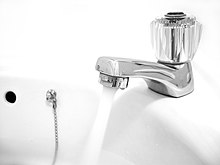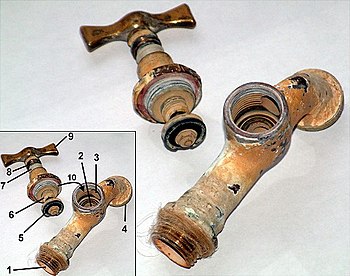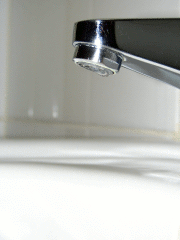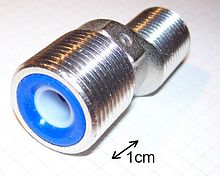water tap
A faucet is an adjustable inflow fitting for water, e.g. for drinking water .
term
The origin of the term “-hahn” has not been proven.
Jakob and Wilhelm Grimm's dictionary lists an entry for Johann Christian Friedrich Keferstein under “Water tap” in his Guide to Agriculture, which was published in 1791 .
It is likely that the term is derived from the fact that the operating part of a faucet earlier often in the form of a rooster had (found, for example, already in 1496 in Albrecht Dürer 's woodcut for men only ).
The word part “chick” in the cockerel cock could have been derived from the “cock”.
In some parts of Germany ( Cologne , Münster , Saarland , Sauerland , Wittgensteiner Land , Ruhr area , Bergisches Land ) the water tap is also called a water crane . In Switzerland there is the name water tap , in Austria water pipe .
General
The original principle of the shut-off valve is the plug valve , in which the so-called plug releases or closes the flow cross-section. Most of today's faucets block the water flow through a valve disk that is pressed vertically onto a sealing surface, or use ceramic sealing washers. When speaking of a "faucet", the technical terminology usually means a shut-off valve or a slide with ceramic sealing washers. The modern mixer taps or single-lever mixers are also not faucets in the technical sense, but rather slide valves . Here the water flow is released by shifting two ceramic disks, one on top of the other, until their holes are on top of each other. Alternatively, a perforated ceramic ball can be used.
Closing a plug or ball valve quickly can lead to a pressure surge (water hammer) in a pipeline . For this reason it is avoided to use plug or ball valves with a larger flow in drinking water pipes.
While so-called mixer taps are predominantly used in the German-speaking area today , there are two separate taps in Great Britain and other countries, one for cold and one for hot water. This has the disadvantage that you have to choose cold or hot water and you cannot choose a mixed temperature. One reason for this is often the lower pressure of the hot water. In a mixer tap this would make mixing difficult and the cold water could press back into the hot water pipe. One solution are "quasi-mixer taps" that look like ordinary mixers but have two separate outflow lines. The streams of water therefore flow side by side from a tap and only mix after exiting the outlet.
Standing taps (e.g. on wash basins ) are referred to as standing taps in the specialist trade and trade . They are assembled with a faucet wrench .
In the Italian municipality of San Maurizio d'Opaglio there is a museum of the faucet (Museo del Rubinetto) . The place became known as the “capital of the faucet” in the 20th century.
construction
The picture on the left shows a schematic cross-section of a simple faucet that has been obsolete since the late 20th century.
The picture on the right shows the numbered individual parts:
The external thread (10) of the valve insert is screwed out of the housing. On his head he wears the cock (9), which is connected to the spindle (6) via a fixed axis. The pitch of the spindle determines the stroke of the valve seal (5) when turning. If the tap is closed, the seal (5) blocks the water inlet (2). If the seal is lifted by turning the tap, the water runs through the inlet (2) into the outlet (3). The stuffing box (7) and the retaining screw (8) in the valve insert prevent the water from escaping along the spindle at the top of the tap. On the ½ inch thread (1) you can see remains of the hemp , which was used to seal the screw connection on the water pipe. The water outlet (4) has a 3/4-inch external thread for screwing on a hose nozzle or a jet regulator .
In kitchens and bathrooms, jet regulators (mixing nozzle, diffuser, aerator) are often used to add air to the water.
Flow rate
The minimum water pressure for bath, shower and basin fittings according to DIN 1988-30 is 1000 mbar. The flow rate at the tap of a bathtub or shower is 15 to 25 l / min. 7 l / min is sufficient for hand washing if a jet regulator expands the water jet.
Soundproofing
The usability of water taps or, in general, fittings and devices of the water installation, to which requirements are placed with regard to the noise behavior (e.g. fittings in apartment buildings), must be proven by a general building authority test certificate (AbP). According to the building regulations list A, part 2, the manufacturer declares that the building product complies with the technical rule (AbP) after prior testing of the building product by a recognized testing agency. The construction product must be marked with the conformity mark (Ü mark) of the federal states. The noise level for the fittings group I described in the standard may:
- at 3 bar 20 dB (A)
- at 5 bar 25 dB (A)
and for fittings group II:
- at 3 bar 30 dB (A)
- at 5 bar 35 dB (A)
do not exceed. For discharge devices, e.g. B. backflow preventer or jet regulator, the limit values are again 5 dB (A) lower than for fittings.
To achieve these limit values z. B. used in the usual bathtub fittings S-pieces water silencers, which dampen the noise of the water column and the pressure surge when closing the fitting via elastic elements .
Research on leaky faucets
Dripping faucets were researched in the context of chaos research in the early 1980s . The drops were measured as a function of the flow rate ; it was about bifurcation , hysteresis and attractor .
See also
literature
- Walter Drack: On the history of the faucet. The Roman water fittings and medieval taps from Switzerland and the Principality of Liechtenstein (= communications from the Antiquarian Society in Zurich . Volume 64). Rohr, Zurich 1997, ISBN 3-85865-513-9 .
Web links
Individual evidence
- ↑ faucet. In: Jacob Grimm , Wilhelm Grimm (Hrsg.): German dictionary . tape 27 : W – way [twittering] -zwiesel - (XIII). S. Hirzel, Leipzig 1922 ( woerterbuchnetz.de ).
- ↑ Third round - faucet . Atlas of everyday German language (AdA), Phil.-Hist. Faculty, University of Augsburg, June 19, 2006
- ↑ Dimensioning of the drinking water installation - differentiated procedure according to DIN 1988-300 (PDF)
- ↑ How loud are cheap fittings? Fraunhofer Institute for Building Physics
- ↑ Robert Shaw: Dripping Faucet As A Model Chaotic System (= The Science Frontier Series ). Areal Press, Santa Cruz 1984, ISBN 0-942344-05-7 ( archive.org ).






